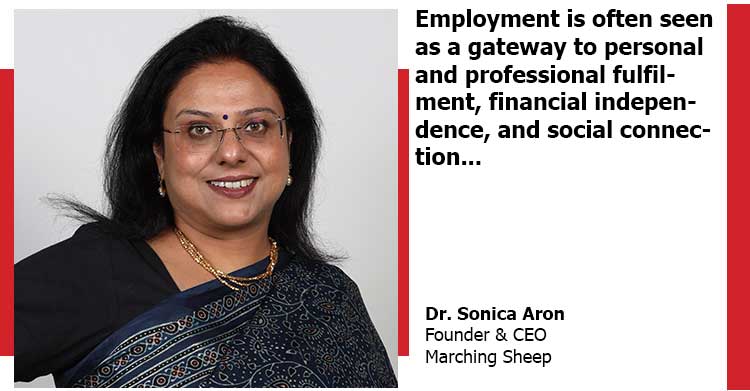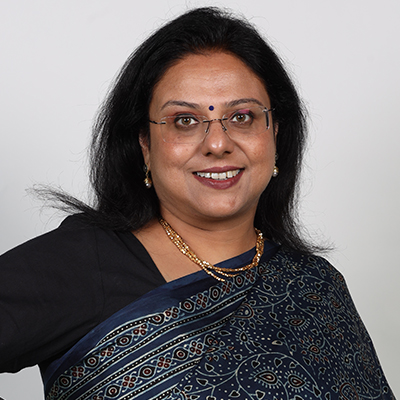How can Companies support people with disabilities at workplace? | Sonica Aron | Founder & CEO | Marching Sheep

Employment is often seen as a gateway to personal and professional fulfilment, financial independence, and social connection. The excitement of starting a new job can be palpable—new responsibilities, the opportunity to meet new colleagues, and the prospect of professional growth; all this can ignite a new sense of purpose. But for individuals with disabilities is it the same feeling? Maybe not. For persons with disabilities this journey is frequently accompanied by a unique blend of hope and concerns about acceptance, understanding, and potential discrimination that can overshadow their enthusiasm.
For them, the workplace can feel like a space where their abilities are often overlooked due to societal stereotypes and misconceptions. As they prepare to enter this new environment, they may be beleaguered by fears that their colleagues will not understand their needs or that they will be perceived as less capable. The anxiety of being labelled as a “diversity hire” is significant. Questions in their minds are plenty including “Will I be welcomed?” or “Will I face exclusion?” These fears reflect broader societal perceptions about disability, trust deficit between people with disabilities and non-disabled people.
Historically, we’ve seen five primary models of disability, or in layman language lenses through which disability has been viewed. The moral model sees disability as a stigma or punishment for past sins, often leading to negative attitudes and pity. In contrast, the medical model treats disability as something that needs to be fixed, focusing on individual health issues without considering the social context. The social model shifts this focus, arguing that disability is caused by barriers in society rather than the individual’s condition, and calls for removing these obstacles to allow full participation. The human rights model emphasizes that people with disabilities have the same rights as everyone else and advocates for equality without discrimination. Lastly, the biopsychosocial model looks at how biological, psychological, and social factors interact to shape a person’s experience of disability.
Today, we are moving towards a more integrated perspective that values a person’s individuality and uniqueness as an asset rather than any one dimension of their identity to be a limitation. There is growing acknowledgement of the fact that no person is defined by any of part of their identity- be it gender, sexual orientation, disability, race or ethnicity, color of skin or any other. A person is a unique combination of multiple facets of diversity dimensions. Inclusion advocates leveraging strengths of every unique individual and creating equitable environments so that everyone thrives.
With the evolving landscape and awareness around PWDs, recent initiatives like the Supreme Court of India’s emphasis on person-first language through a comprehensive handbook reflect this change, which prioritizes the individual over their disability and fostering an environment where everyone can feel confident. For instance, saying “a person with a visual impairment” rather than “the blind person” not only reflects sensitivity but also reinforces the idea that disabilities are just one aspect of a person’s life. This evolution signifies a broader recognition of the rights and capabilities of individuals with disabilities, paving the way for a more equitable world where all can contribute meaningfully to society without fear of marginalization or misunderstanding.
The handbook advises against euphemisms like ‘differently abled’ or ‘specially abled’. Instead, it promotes the use of more respectful alternatives, such as ‘person with a disability.’ This shift to person-first language is crucial in dismantling the stigma that often surrounds disabilities. This movement aligns with global efforts to promote disability rights and inclusion. Various acts worldwide, such as the Americans with Disabilities Act (ADA) in the United States and the United Nations Convention on the Rights of Persons with Disabilities (UNCRPD), aim to ensure equal opportunities for individuals with disabilities. These frameworks advocate for accessibility, non-discrimination, and full participation in society.
To truly become a disability-confident organization, companies must go beyond merely implementing policies; they need to cultivate a culture that embraces inclusivity at every level. This transformation begins with a commitment to understanding the unique challenges faced by individuals with disabilities and actively working to dismantle barriers in the workplace. The fact is that Inclusion begins with awareness, and understanding the diverse spectrum of disabilities is crucial for creating a truly inclusive environment. The Rights of Persons with Disabilities Act (RPWD Act) recognizes 21 different types of disabilities, encompassing both visible and invisible conditions. This broad categorization reminds us that disabilities can manifest in various forms, from physical impairments to mental health challenges, and each requires a nuanced understanding.
Organizations can start by assessing their current practices and identifying areas for improvement. This involves not only creating accessible environments—both physically and digitally—but also ensuring that recruitment processes are inclusive and welcoming. There is a need to understand that while physical infrastructure is crucial—such as ramps, elevators, lighting, noise free spaces and accessible restrooms—it is only one piece of the puzzle. Digital accessibility is equally important; websites and internal systems must be designed to accommodate various disabilities. Then comes the mindset shift. Inclusion is not just the responsibility of the HR team or the leadership, and therefore, every employee needs to be sensitised on different disabilities, symptoms, reasonable accommodations people might need, how to create an environment of allyship, inclusive language and behaviours, do’s and don’ts. Lastly, all policies and processes need to be viewed from the lens of universal design.
Well-articulated, socialised and implemented policies not only underscore the organization’s commitment to inclusion but also provide actionable steps for employees at all levels. For example, having a robust Disability & Reasonable accommodations approval process can guide how accommodations are made for employees with disabilities, ensuring they have equal opportunities to succeed. Ensuring that all learning programs have sign language interpreters drives inclusion of people with hearing disabilities. Revisiting medical insurance to ensure mental illness coverage, or leave policy to provide for caregiver flexibility are other instances that demonstrate thoughtful consideration of different needs of different people in the organisation.
We need to understand that continuous and consistent reinforcement of inclusive practices is essential for long-term success. This means integrating inclusive efforts practices across various touchpoints within the organization—from onboarding processes to town hall meetings to team meetings to career conversations and so on. For example, during onboarding, new hires should receive training that emphasizes the importance of inclusivity and provides practical tools for fostering an inclusive workplace. They should also be informed about the range of benefits accessible, the culture of disclosure, processes and people to speak with in case of any concern.
Visual communication also plays a significant role in promoting inclusivity. Infographics or posters around the workplace can serve as constant reminders of the organization’s commitment to diversity and inclusion. These visual cues help normalize conversations about disabilities and encourage employees to engage with the topic regularly.
Establishing Employee Resource Groups (ERGs) can provide a platform for individuals with disabilities to connect, share experiences, and advocate for necessary changes within the organization. These groups not only empower employees but also serve as valuable resources for leadership to understand the unique challenges faced by their workforce.
In addition to internal efforts, organizations should engage with external disability inclusion specialists who can offer guidance on best practices and help implement effective strategies. Collaborating with organizations that specialize in disability employment can enhance an organization’s commitment to inclusivity and ensure that they are meeting industry standards. Ongoing evaluation is crucial for ensuring that inclusivity efforts are effective and meaningful. Organizations should regularly assess their practices through feedback mechanisms and performance metrics to identify areas for improvement. This commitment to continuous improvement sends a powerful message: that inclusivity is not just a one-time initiative but an ongoing journey.
Ultimately, becoming a disability-confident organization is about creating a culture of belonging where everyone—regardless of ability—can contribute meaningfully. Inclusion is not merely a checkbox on a compliance list; it is a heartfelt commitment to fostering an inclusive environment where every individual feels valued and empowered. It’s essential to recognize that disability can touch any of us at any time—whether through an accident, illness, or the natural aging process. This reality underscores the importance of creating workplaces that prioritize accessibility and inclusivity for everyone. When we invest in inclusivity, we not only enhance the lives of individuals with disabilities but also enrich our workplaces and communities as a whole. This journey requires genuine care and understanding, as well as a willingness to listen to the voices of those with disabilities. By promoting open dialogue and actively engaging with employees at all levels, organizations can cultivate a culture that celebrates diversity in all its forms.


